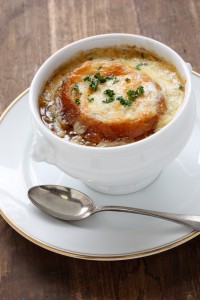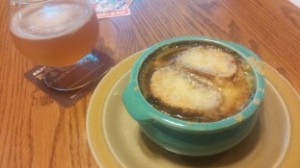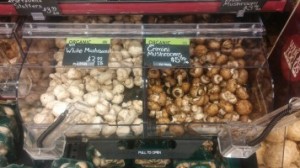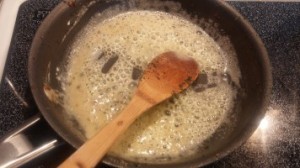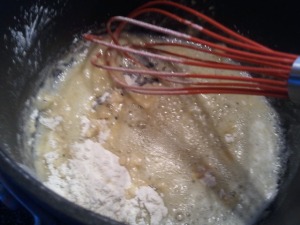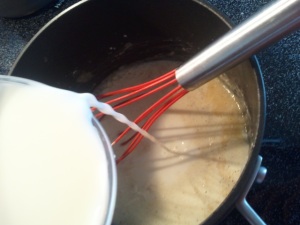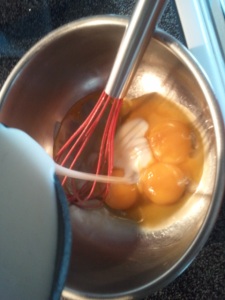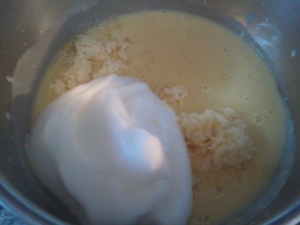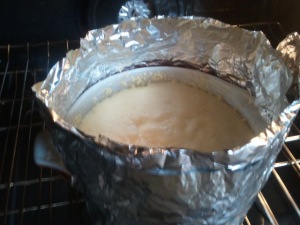For such a relatively simple and rustic-style dish, the obsession over French Onion Soup is quite palpable; in mentioning it to just a few people, the enthusiasm over me doing THIS recipe was notably high. Truly it proves that this must be one of France’s categorical foodson line with Poutine, Apple Pie, and other soul foods. I mean, it IS just a pile of cooked onion, bread, and broth covered in thick cheese.
For such an all-encompassing, highly simple-minded dish (I mean it’s basically onion broth and cheese, how does one record the official ‘creation’ of this?), I didn’t really expect to read any proper origin story. But to my little surprise I actually found a couple interesting things. First up being a ‘story’ of King Louis the XV (sooooooo probably fake, but amusing) and his hunting party looking for food in their cabin, only to find onions, butter, and champagne. Then in the 19th century people started actually seasoning with salt n pepper, using flour to thicken slightly, and topping with cheese (and also likely when the bread, normally served on the side, was moved under the cheese).
Apparently the real origin likely lies in the Lyonregion, this dish’s proper name being Soup A L’Oignan A La Lyonnaise. There’s a good chance this originated with the ‘canuts,’ the backbone workers of Lyon’s silk industry, working 18 hrs a day weaving and screening. Forced to make dishes that will sustain them for the long day, but with very little actual resources to work with, they had to be creative. At this time, and really every one thereafter, onions were a very cheap and readily-acquired, easy-to-grow food source. Combine that with the ease and soul-restoring properties of making soup, and it’s no difficult feat to see these workers taking mounds of these guys, cooking it hard for extra flavor, and stewing it over long hours before consuming in big bowls.
However it started, and evolved from the humble onion-soup origins centuries past, having since elevated to one of the cultural favorites featured in high-class, traditional French restaurants alongside the rustic taverns and cafes. I can’t wait to get into crafting this caramelly-sweet masterpiece.
A Word On…
Caramelizing Onions: I do love caramelized onions, though truth be told I don’t think I’ve ever made some that I’ve been fully satisfying with. I mean how often have I seen them make it on tv, doing practically nothing (once saw Paula Dean just slice them thick and put them in a covered pot for most of an hour) and come out perfect deep golden throughout? So for this one I decided to officially research for some more tips, and here’s some nice things to know, for this dish or any.
Don’t cut TOO thin, having a bit of width helps to stick and sear/caramelize on the bottom of the pan.
Go for general Nonstick pans or Cast Iron to help the most with controlling and moving the onions about as they caramelize well, creating SOME pan fond but not too much.
Speaking of too much fond (crusty stuff on the pan), I’ve always run into the issue, as you go later on, of the pan bottom getting dangerously crusty. I always worry about it actually burning. Then I ran across this tip to add a few tablespoons of water at that point. It doesn’t sound proper, but hey it actually works; the bottom clears out, the water evaporates and you can go back to cooking, and best of all (two things actually) the fond gets distributed among the onions, making them more caramelly, and it allows us to cook them at higher temperatures. A very risky thing to do without burning, but the water helps to relegate this, so you can caramelize it more and cook it faster.
If you don’t know by now, you need a LOT of onions for this. They do shrink down quite a bit after cooking, and I plan on making a big pot. Soooo, the question then becomes… is there an official volume and weight for ‘shitload’ of onions like this?
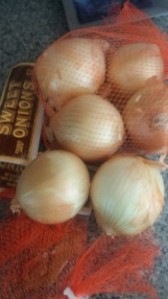 Finally, as for the soup, what onions to use? Do you do one for capitalize on a single trait, or a blend of different for rounding purposes? I say first stick with one, since that’s generally how it’s done… and I doubt the original laborers had the luxury of choice. Then, do you choose the typically assumed Sweet Onion varieties (like Vidalia) or Yellow? One would think the first, but apparently there are people online saying otherwise… mainly based on flavor. The sweet onions ARE sweeter, but though the yellow are more pungent (at first), after cooking apparently they develop more of these deeper flavors to enjoy. I myself am still going for the Sweet, because I want to ensure those sugars and caramelly qualities this time, but I would certainly try the yellow at some point in the future.
Finally, as for the soup, what onions to use? Do you do one for capitalize on a single trait, or a blend of different for rounding purposes? I say first stick with one, since that’s generally how it’s done… and I doubt the original laborers had the luxury of choice. Then, do you choose the typically assumed Sweet Onion varieties (like Vidalia) or Yellow? One would think the first, but apparently there are people online saying otherwise… mainly based on flavor. The sweet onions ARE sweeter, but though the yellow are more pungent (at first), after cooking apparently they develop more of these deeper flavors to enjoy. I myself am still going for the Sweet, because I want to ensure those sugars and caramelly qualities this time, but I would certainly try the yellow at some point in the future.
 Broth: it is certainly true one can use chicken broth or –shudders- ‘water’ to make this, but beef broth has been the readily accepted stock for decades, so that’s what I’ll use. Though I’ve read plenty of complaints about the store-bought beef broths, so why not just make my own? So I just grab some beef neck bones (and a cow foot… yes a cow foot. I wanted to see what it tasted like afterwards okay?), roasted them with big chunks of onion, carrot, and celery, and into the pot it went.
Broth: it is certainly true one can use chicken broth or –shudders- ‘water’ to make this, but beef broth has been the readily accepted stock for decades, so that’s what I’ll use. Though I’ve read plenty of complaints about the store-bought beef broths, so why not just make my own? So I just grab some beef neck bones (and a cow foot… yes a cow foot. I wanted to see what it tasted like afterwards okay?), roasted them with big chunks of onion, carrot, and celery, and into the pot it went.
Let simmer all day and all night, and that’s a lovely pot of beef-flavored water. Oh you should see it after it’s strained, skimmed (this puppy generates a LOT of fat on top that needs removal), and put in the fridge; it turns into JELLY. Now that’s the sign of a good stock.
Booze: It’s not an onion soup without at least a little bit of alcohol. The first requirement is the hard stuff; if there’s anything that seems to make its way into almost every recipe, it’s some kind of Brandy. Cognac is one of the ideals, but being well-focused along the Parisian, Loire, and Normandy area, where apples grow abundant in the cool climate, Apple Brandy has been used just as traditionally. And it’s delicious. Regular brandy works too, but if you really want the experience it’s always fun to go to a proper Cognac (still stick with the cheaper stuff, you are cooking afterall) or Calvados. Being unable to choose myself, I used a combination of some rather high quality Cognac and aged Calvados… don’t ask me how I got it, I can’t answer that question publicly.
Wine becomes debatable, though when used it’s in notably higher quantities than the spirit. Also one can use Red or White, I think the latter may be more traditional (having now looked up the King Louis story with champagne), but the ultimate decision is likely depended upon whether one is going for a deeper, darker onion soup or something lighter (not so intensely caramelized and with chicken stock).
C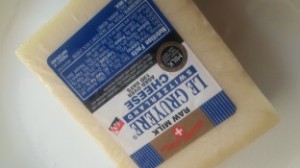 heese: Gruyere, pure and simple. Now how it goes on may have debate… there are those that like having the bread and cheese basically plugging the top, even just using a thick slice of the fromage over the bowl so that it forms a fully melted seal, goes messily over the side and all that. Then there are those that stick with shredding and using a small bread piece so that more of the cheese melts INTO the soup while broiling. I’ve even seen a recipe that puts a layer of bread and cheese in the middle before ladling more soup and then a final cover on top to fully integrate it. I wanna try shredding, but seeing if I can get a decent amount on top for a full seal (can’t say I’ll be successful in my ideals), as I still want the soup mostly separated from it initially.
heese: Gruyere, pure and simple. Now how it goes on may have debate… there are those that like having the bread and cheese basically plugging the top, even just using a thick slice of the fromage over the bowl so that it forms a fully melted seal, goes messily over the side and all that. Then there are those that stick with shredding and using a small bread piece so that more of the cheese melts INTO the soup while broiling. I’ve even seen a recipe that puts a layer of bread and cheese in the middle before ladling more soup and then a final cover on top to fully integrate it. I wanna try shredding, but seeing if I can get a decent amount on top for a full seal (can’t say I’ll be successful in my ideals), as I still want the soup mostly separated from it initially.
Cooking Vessel: I’m sure many of us are familiar with the classic ‘French onion soup bowl,’ we’ve seen this brown and white oven proof miniature chamber pot on plenty of tv shows, in recipes/pictures, and possibly in person. Whether or not we have bowls that are of this same design is dependent upon what’s shoved in the back of our pantry, but I don’t imagine most people do. Though I will say I actually happen to have a similar dish that used to belong to my grandmother (only it’s very notably bright teal color… you’ll see). But no worries, any oven-proof ceramic-type bowl or large ramekin will work. If all else fails, one could even broil off the soup en-masse in a casserole dish, top covered in bread and slices of cheese. That’s what I did (well I only had the ONE bowl, and the others were quite ornery about wanting food…), spooned them each some of the topping and soup beneath, and it worked out rather well.
Soupe a L’Oignon (a la Lyonnaise… sorta)
2 Tb Butter
2½ – 3lbs Sweet Onions
2-3 Bay Leaves
2 Tb Flour
¾ cup Red (or white if preferred) Wine
3/8 cup quality Brandy of choice (Cognac, Calvados, and/or other)
6-8 cups Beef Broth
6 Thyme Sprigs
Salt and Pepper
Baguette
½ lb Gruyere, shredded
Directions
- Halve, peel, and slice Onions about 1/8” thick on the vertical
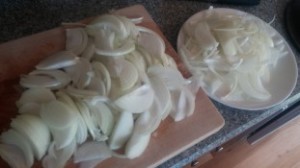
- Heat up a wide, large, ideally cast-iron pot on just over medium heat
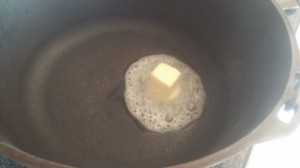
- Throw in Butter and onions, stirring to coat

- Cook, stirring occasionally, as the onions slowly caramelize. As they sweat and reduce in size, stir more often, scraping them up and around as the bottom of the pile browns over and over again.
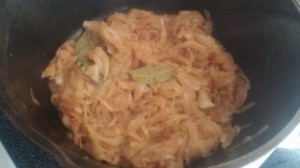
- Add bay leaves when it’s mostly golden, now most likely stirring constantly. If and whenever the pan bottom gets really crusty from the fond, add 3-4 Tb of Water to pan, deglazing and stirring the brown bits evenly among the onions. Repeat whenever it gets crusty.
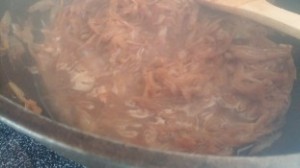
- After about 45 minutes of total cook time, onions should be an even caramelly dark brown. Stir in Flour, keep stirring for about a minute (should smell very lightly nutty)
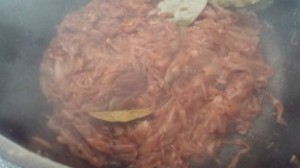
- Add in Wine and half of the Brandy, briefly deglazing and letting bubble.

- Pour in Beef Stock and Thyme, bringing to a boil and cooking about 15 minutes for flavors to come together.

- Add remaining Brandy, season Salt and Pepper, and turn down heat to low, keeping warm for service.
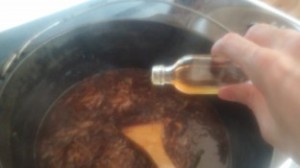
- Turn oven to 400F or Toasting setting and prepare Baguette. Slice into thick segments, butter if desired, and bake in the oven until top is brown and crusty.
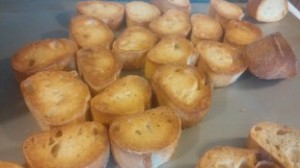
- Adjusting oven to Broil setting and start transferring soup (bay leaves and thyme removed) to deep oven-proof bowls or casserole pots, stopping 1 inch under the lip.
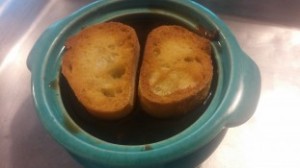
- Top with baguette slices to take up most of the space and generously pile with Gruyere to make a thick, even layer.

- Broil for a few minutes, until the cheese is melted, bubbly, and potentially lightly golden.

- Carefully remove, transfer to plate, and dig in.
The Verdict
I swear, visually at least (didn’t taste them at the time), this is the best batch of caramelized onions I’ve done so far. I really think the combo of their size, cast iron pot, and the water trick really did the trick. So for that at least I am VERY glad and grateful that I went through this recipe. Oh, and for the chance to make my own beef stock (haven’t done that since college).
 Overall, the final result was most deeply satisfying, especially to my dinner guests. Rather deep, tender caramelly onions, and with that awesome gooey swiss cheese aspect. Bread was a bit annoying to spoon through, I either should have cut them thinner or had a not so tight/dense product. Some sort of country loaf maybe? In regards of the flavor, though, I did find there to be this notable bitter aspect that I couldn’t shake… at least in the soup on its own, eaten with everything else it actually wasn’t so bad, and almost worked alright. Though I don’t blame that on the recipe, probably something to do with my treatement of the onions, the brandy, or maybe an effect of our pot (it IS old and I know for a fact that it wasn’t seasoned properly once or twice, did NOT smell so good… but we fixed that a while back).
Overall, the final result was most deeply satisfying, especially to my dinner guests. Rather deep, tender caramelly onions, and with that awesome gooey swiss cheese aspect. Bread was a bit annoying to spoon through, I either should have cut them thinner or had a not so tight/dense product. Some sort of country loaf maybe? In regards of the flavor, though, I did find there to be this notable bitter aspect that I couldn’t shake… at least in the soup on its own, eaten with everything else it actually wasn’t so bad, and almost worked alright. Though I don’t blame that on the recipe, probably something to do with my treatement of the onions, the brandy, or maybe an effect of our pot (it IS old and I know for a fact that it wasn’t seasoned properly once or twice, did NOT smell so good… but we fixed that a while back).
If I ever do this again, I really wanna try using a whole slice of cheese over the soup instead of grated, go for that thick, draping-layer cheese effect. Maybe see what happens with that lighter caramelized onions (see pic with the bay leaves) with white wine for a different style. I’d also like to try the basic yellow onion base instead, see if they actually create more, and a better, flavor. But that’s for the future.
Primary Pairing – Dark Belgian Beer
 First off let me say; not a Stout, or Porter, or similar black styles. I’m thinking more of those nice dark brown, rich, almost tavern beers, but better. As much as this recipe can be made as a finessed, high-end dish, I still feel it really connects more with a rustic bowl of comforting soul food. Definitely the kind that at times makes me want a nice satisfying pint of beer to chug down alongside it. Especially something with similar dark, malty flavors to compliment the caramelly onions and broth and a rich body.
First off let me say; not a Stout, or Porter, or similar black styles. I’m thinking more of those nice dark brown, rich, almost tavern beers, but better. As much as this recipe can be made as a finessed, high-end dish, I still feel it really connects more with a rustic bowl of comforting soul food. Definitely the kind that at times makes me want a nice satisfying pint of beer to chug down alongside it. Especially something with similar dark, malty flavors to compliment the caramelly onions and broth and a rich body.
With a quality Belgian, we shouldn’t have to worry about large levels of hops to interfere with things, not to mention we can bring in special flavors and complexity to the overall experience. A dear lesson I learned when dealing with ‘special food and wine’ pairings; where it’s clear to see that the better quality food one has, one should try to match with a similar quality drink. But the COMPLEXITY depends on the dish, and not in the way one might think; put simply, if the food is simple but nice, say a really good filet mignon with potatoes, one can have a deeply complex wine to enjoy, and vice versa. Simple and simple works well too, but complex food and complex wine is a definite NO, as the flavors can so easily get all mixed up and muddled; it’s possible to find ones that pair perfectly, but insanely difficult. Better to let one of them shine in its developed and special flavors while the other acts as a supporting base, allowing you to fully enjoy each part. And with a very simple, rustic, but really good quality French onion soup, a beer with extra aspects is definitely acceptable; and I like the idea of Belgians.
Oh, and I also didn’t have any wine prepared to go with this, so I just used a beer I had in the basement instead, so yeah.
My Bottle: St Stefanus Biere d’Abbaye Belge Grand Cru Dubel (or Tripel? Can’t remember)
Certainly a classic Belgian multi-grain abbey ale, St Stefanus delivers a smooth, delectable and refreshing malty craft beer. A golden draft of medium-bodied, frothy creation leads to light notes of fruit, barrel, and some other yummy things. Truly an enjoyable, quality beverage that I would love to sit back and enjoy on a sunny deck day afternoon.
But, here’s the thing: it didn’t go well with the soup. I admit it, I made a mistake and didn’t create a proper pairing between these two. I did end up creating this awesome feeling of being in an old, run down pub/tavern, hot and bready onion-cheese soup and what tasted like rough, malty beer next to it that was reminiscent of something drunk out of a wooden tankard. But the soup completely overshadowed all those delicious delicate flavors and aspects I just mentioned, the beer wasn’t as heavy, dark, and deep as it should have been to stand a chance. It’s an unacceptable result in my book, and I hope it doesn’t repeat anytime soon.
Secondary Pairing – Loire/Coteaux du Layon Blanc (White Table Wine level)
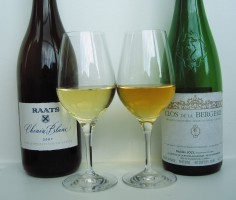 There’s no actual meat or anything with proper chew or texture here, all soft, so there is no need or desire (in fact, you’ll ideally want to avoid) for any red wine. If absolutely desiring, maybe something from Beaujolais, a super light red of Cab Franc and/or Gamay in the Loire, or a Rose. But whites are desired here, especially to help cut through the fatty cheese. Loire whites being often Chenin Blanc based, which brings a solid acidity for this, a richer medium-ish body and thicker mouthfeel to match the soup’s own, and often even a bit of sweetness which could go nicely with that of the onions (and help with the cheese). Sometimes they’ll even have a bit of toasty barrel, or something reminiscent of malo-lactic buttery effects, all things which could make a tasty pair alongside our soup.
There’s no actual meat or anything with proper chew or texture here, all soft, so there is no need or desire (in fact, you’ll ideally want to avoid) for any red wine. If absolutely desiring, maybe something from Beaujolais, a super light red of Cab Franc and/or Gamay in the Loire, or a Rose. But whites are desired here, especially to help cut through the fatty cheese. Loire whites being often Chenin Blanc based, which brings a solid acidity for this, a richer medium-ish body and thicker mouthfeel to match the soup’s own, and often even a bit of sweetness which could go nicely with that of the onions (and help with the cheese). Sometimes they’ll even have a bit of toasty barrel, or something reminiscent of malo-lactic buttery effects, all things which could make a tasty pair alongside our soup.

